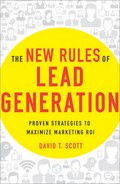SEM vs. SEO
SEM should not be confused with search engine optimization (SEO). SEO is the practice of using keywords in strategic places on your website (in the page title, content, headings, etc.), so that the site or webpage gets a higher organic ranking in search results on a search engine. Although SEO can be used for lead generation, you will get quicker results and will generate more reliable leads using search engine marketing ads.
I won’t talk much about SEO in this book, because I don’t consider it a standard, quantifiable lead-generation tactic. Yes, SEO can be used as a lead-generation tool, just as billboards and TV/radio advertising can be used for that purpose. But the primary function of SEO is to increase your site’s ranking in “natural search” results, not to generate leads.
SEO is a very unreliable way to produce leads because the placement of your website in “natural, organic search” is largely out of your control. The goal of SEO is to convince the search engine bots—the programs that index your website—that your webpage is the most relevant one for the keywords being searched. You can work on SEO for months, and your site may still not get the “natural search” traffic you want. Search engines like Google constantly change their algorithms so that search results can’t be fixed or manipulated by savvy marketers like us. This makes SEO a cat-and-mouse game that you can never be sure of winning.
Also, it’s very hard to quantify SEO as a lead-generation tool because you can’t be sure how many leads actually came from your SEO efforts. For example, suppose someone visits your site and signs up as a lead. How do you tell whether that person found you on a search engine thanks to SEO, or visited your site after seeing your latest billboard ad or hearing about your company from a friend? Perhaps a combination of these factors led the person to visit your site. Measuring your lead-generation results with SEO is very difficult, whereas, with SEM, the number of leads you get from the tactic is very easy to measure.
The main element that SEM shares with SEO is the concept of using keywords and keyword phrases to allow a site or ad to rank higher in search results. The difference is, with SEM, you pay for the privilege of having your ad placed in the “ad spaces” at the top or side of the list of natural/organic search results. This way, your ad will be one of the first results that searchers notice when they search for those keywords.
As a marketer, you bid a PPC rate (i.e., $2.50 per click) for any keywords that you think your potential customer will enter when searching for your type of product or service. Of course, you are also competing with other marketers who are bidding PPC rates on the same keywords or keyword phrases. The SEM ads with the highest PPC bids get the highest ranking in search results. Ads with lower bids may be displayed on the second or third page of search results, where they are less likely to be seen. (Or the lower-bidding ads may not even be displayed at all.) So the higher a PPC rate you can bid on a keyword or keyword phrase, the more likely your SEM ad is to be displayed in search engine results.
